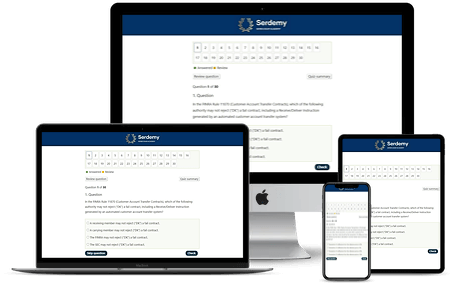Quiz-summary
0 of 30 questions completed
Questions:
- 1
- 2
- 3
- 4
- 5
- 6
- 7
- 8
- 9
- 10
- 11
- 12
- 13
- 14
- 15
- 16
- 17
- 18
- 19
- 20
- 21
- 22
- 23
- 24
- 25
- 26
- 27
- 28
- 29
- 30
Information
Premium Practice Questions
You have already completed the quiz before. Hence you can not start it again.
Quiz is loading...
You must sign in or sign up to start the quiz.
You have to finish following quiz, to start this quiz:
Results
0 of 30 questions answered correctly
Your time:
Time has elapsed
Categories
- Not categorized 0%
- 1
- 2
- 3
- 4
- 5
- 6
- 7
- 8
- 9
- 10
- 11
- 12
- 13
- 14
- 15
- 16
- 17
- 18
- 19
- 20
- 21
- 22
- 23
- 24
- 25
- 26
- 27
- 28
- 29
- 30
- Answered
- Review
-
Question 1 of 30
1. Question
Momentum Strategies Advisors, a registered Commodity Trading Advisor (CTA), has developed a sophisticated new trading algorithm. To attract new clients, the firm’s marketing department creates a brochure that prominently features the algorithm’s performance, which has been back-tested over the past five years, yielding impressive hypothetical returns. To ensure compliance before distributing this brochure, what specific action must the firm take regarding the presentation of these hypothetical results according to NFA Compliance Rule 2-29?
Correct
The correct action is dictated by NFA Compliance Rule 2-29(c), which governs the use of hypothetical performance results in promotional material. The rule explicitly requires that any presentation of hypothetical results must be accompanied by a prescribed cautionary statement. This statement must inform the prospective client that hypothetical performance results have inherent limitations. One of the primary limitations is that they are generally prepared with the benefit of hindsight and do not involve actual financial risk. Consequently, no representation can be made that any account will or is likely to achieve profits or losses similar to those being shown. The rule’s purpose is to prevent misleading the public by ensuring they understand the significant differences between simulated trading and actual trading. While a CTA must have supervisory procedures in place for all promotional material under NFA Rule 2-9 and maintain records, the specific, mandatory action for using hypothetical data is the inclusion of this specific disclaimer. Obtaining pre-approval from the NFA for every piece of promotional material is not a standard requirement, and while financial records for a CPO must be audited, this is not the case for a CTA’s hypothetical performance data. The rule focuses on transparent disclosure of the data’s limitations.
Incorrect
The correct action is dictated by NFA Compliance Rule 2-29(c), which governs the use of hypothetical performance results in promotional material. The rule explicitly requires that any presentation of hypothetical results must be accompanied by a prescribed cautionary statement. This statement must inform the prospective client that hypothetical performance results have inherent limitations. One of the primary limitations is that they are generally prepared with the benefit of hindsight and do not involve actual financial risk. Consequently, no representation can be made that any account will or is likely to achieve profits or losses similar to those being shown. The rule’s purpose is to prevent misleading the public by ensuring they understand the significant differences between simulated trading and actual trading. While a CTA must have supervisory procedures in place for all promotional material under NFA Rule 2-9 and maintain records, the specific, mandatory action for using hypothetical data is the inclusion of this specific disclaimer. Obtaining pre-approval from the NFA for every piece of promotional material is not a standard requirement, and while financial records for a CPO must be audited, this is not the case for a CTA’s hypothetical performance data. The rule focuses on transparent disclosure of the data’s limitations.
-
Question 2 of 30
2. Question
An assessment of the promotional material strategy for Momentum Alpha Advisors, a registered Commodity Trading Advisor (CTA), reveals a key compliance consideration. For its first five years of operation, the firm’s founder, Anya, was the sole principal and exclusively responsible for all trading decisions, generating a documented performance record. At the beginning of year six, Ben joined the firm as a new principal and began sharing responsibility for trading decisions with Anya. Now, in year seven, the firm wishes to create promotional material that presents the full six-year performance history. According to NFA Compliance Rule 2-29, what is the most critical requirement for including the performance data from the initial five-year period in this new material?
Correct
The core issue revolves around NFA Compliance Rule 2-29, which governs communications with the public and promotional material for NFA Members, including CTAs. A fundamental principle of this rule is that all communications must be based on principles of fair dealing and good faith and must not be misleading. When presenting past performance, a CTA must be particularly careful, especially if there has been a material change in the way the trading program is managed. The addition of a new principal who is involved in making trading decisions, like Ben, is considered a material change. Therefore, presenting the performance record from a period before this change (years 1 through 5) could be misleading if the public is led to believe the current principals were responsible for that entire track record. To comply with Rule 2-29, the promotional material must provide clear and prominent disclosure that separates the performance achieved by the prior trading principal (Anya, when she was sole principal) from the current management. The disclosure must explicitly state that the new principal (Ben) was not involved in the trading decisions that generated the performance for that earlier period. This ensures that prospective clients can accurately assess the track record attributable to the current decision-makers and are not misled about the continuity of management and strategy.
Incorrect
The core issue revolves around NFA Compliance Rule 2-29, which governs communications with the public and promotional material for NFA Members, including CTAs. A fundamental principle of this rule is that all communications must be based on principles of fair dealing and good faith and must not be misleading. When presenting past performance, a CTA must be particularly careful, especially if there has been a material change in the way the trading program is managed. The addition of a new principal who is involved in making trading decisions, like Ben, is considered a material change. Therefore, presenting the performance record from a period before this change (years 1 through 5) could be misleading if the public is led to believe the current principals were responsible for that entire track record. To comply with Rule 2-29, the promotional material must provide clear and prominent disclosure that separates the performance achieved by the prior trading principal (Anya, when she was sole principal) from the current management. The disclosure must explicitly state that the new principal (Ben) was not involved in the trading decisions that generated the performance for that earlier period. This ensures that prospective clients can accurately assess the track record attributable to the current decision-makers and are not misled about the continuity of management and strategy.
-
Question 3 of 30
3. Question
Momentum Strategies Advisors, a registered Commodity Trading Advisor (CTA), is developing new promotional material to attract qualified eligible participants. The material prominently features the simulated performance of a new algorithmic trading strategy over the past three years, a period during which the strategy was not actually trading client funds. To ensure compliance with NFA rules regarding communications with the public, which of the following actions is most critical for the CTA to undertake?
Correct
The core requirement for a Commodity Trading Advisor (CTA) using promotional material that includes hypothetical trading results is the inclusion of a specific, prescribed disclaimer. NFA Compliance Rule 2-29(c) mandates that any presentation of hypothetical performance must be accompanied by a statement warning of the inherent limitations of such results. This disclaimer must explicitly state that hypothetical performance results have many inherent limitations, some of which are described below. It must clarify that no representation is being made that any account will or is likely to achieve profits or losses similar to those shown. It must also point out that hypothetical trading does not involve financial risk, and no hypothetical trading record can completely account for the impact of financial risk in actual trading. For example, the ability to withstand losses or to adhere to a particular trading program in spite of trading losses are material points which can also adversely affect actual trading results. There are numerous other factors related to the markets in general or to the implementation of any specific trading program which cannot be fully accounted for in the preparation of hypothetical performance results and all of which can adversely affect actual trading results. The presence of this exact, robust warning is non-negotiable and is considered the most critical element for compliance, as its purpose is to prevent prospective clients from being misled by performance data that was not achieved through the actual management of client funds. While other requirements like maintaining records and having a sound basis for the data are also important, the public-facing disclaimer is the primary safeguard mandated by the NFA for this type of communication.
Incorrect
The core requirement for a Commodity Trading Advisor (CTA) using promotional material that includes hypothetical trading results is the inclusion of a specific, prescribed disclaimer. NFA Compliance Rule 2-29(c) mandates that any presentation of hypothetical performance must be accompanied by a statement warning of the inherent limitations of such results. This disclaimer must explicitly state that hypothetical performance results have many inherent limitations, some of which are described below. It must clarify that no representation is being made that any account will or is likely to achieve profits or losses similar to those shown. It must also point out that hypothetical trading does not involve financial risk, and no hypothetical trading record can completely account for the impact of financial risk in actual trading. For example, the ability to withstand losses or to adhere to a particular trading program in spite of trading losses are material points which can also adversely affect actual trading results. There are numerous other factors related to the markets in general or to the implementation of any specific trading program which cannot be fully accounted for in the preparation of hypothetical performance results and all of which can adversely affect actual trading results. The presence of this exact, robust warning is non-negotiable and is considered the most critical element for compliance, as its purpose is to prevent prospective clients from being misled by performance data that was not achieved through the actual management of client funds. While other requirements like maintaining records and having a sound basis for the data are also important, the public-facing disclaimer is the primary safeguard mandated by the NFA for this type of communication.
-
Question 4 of 30
4. Question
Consider the following situation involving a Commodity Trading Advisor (CTA), “Alpha Wave Capital.” The CTA’s current Disclosure Document is dated March 1, 20X4, and is being used to solicit new managed accounts. On October 10, 20X4, the NFA initiates a formal complaint against the sole principal of Alpha Wave Capital, alleging misleading promotional material, a fact considered material to a client’s decision. Given these circumstances, what is the proper procedure Alpha Wave Capital must follow regarding its Disclosure Document?
Correct
The correct course of action is for the CTA to immediately stop using the current Disclosure Document, amend it to reflect the material change, file the amended document with the NFA, and only then resume using it to solicit clients. Under CFTC Regulation 4.26 and NFA Compliance Rule 2-13, a Commodity Pool Operator or Commodity Trading Advisor has a continuous obligation to ensure its Disclosure Document is not materially inaccurate or incomplete. A significant event, such as a principal being named in a major NFA disciplinary complaint, constitutes a material change that must be disclosed. The moment this event occurs, the existing Disclosure Document becomes materially misleading by omission. Therefore, the CTA must immediately cease distributing it to prospective clients. The CTA is required to promptly amend the document to include the new information. This amended document must be filed with the NFA. Only after the amended document has been filed can the CTA resume using it for solicitation. It is crucial to understand that this interim amendment does not reset the document’s original nine-month validity period. The next comprehensive update will still be due nine months after the date of the original document, which can be extended to twelve months. Relying on a future update or providing only verbal disclosure is not compliant with the rules.
Incorrect
The correct course of action is for the CTA to immediately stop using the current Disclosure Document, amend it to reflect the material change, file the amended document with the NFA, and only then resume using it to solicit clients. Under CFTC Regulation 4.26 and NFA Compliance Rule 2-13, a Commodity Pool Operator or Commodity Trading Advisor has a continuous obligation to ensure its Disclosure Document is not materially inaccurate or incomplete. A significant event, such as a principal being named in a major NFA disciplinary complaint, constitutes a material change that must be disclosed. The moment this event occurs, the existing Disclosure Document becomes materially misleading by omission. Therefore, the CTA must immediately cease distributing it to prospective clients. The CTA is required to promptly amend the document to include the new information. This amended document must be filed with the NFA. Only after the amended document has been filed can the CTA resume using it for solicitation. It is crucial to understand that this interim amendment does not reset the document’s original nine-month validity period. The next comprehensive update will still be due nine months after the date of the original document, which can be extended to twelve months. Relying on a future update or providing only verbal disclosure is not compliant with the rules.
-
Question 5 of 30
5. Question
The following case demonstrates a complex compliance situation. Kenji is a registered Associated Person (AP) at “Sterling Futures Clearing,” a large Futures Commission Merchant (FCM). He also independently owns and operates “Zenith Algorithmic Trading,” a registered Commodity Trading Advisor (CTA). To attract clients for his CTA, Kenji launches a website that prominently features a track record of hypothetical performance based on a new algorithm. While the website includes a standard NFA disclaimer about the limitations of hypothetical results, the header of every page on the Zenith Algorithmic Trading website displays the official logo of Sterling Futures Clearing. Considering NFA Compliance Rules, what is the most significant compliance failure identified in this scenario?
Correct
NFA Compliance Rule 2-9 imposes a fundamental duty on NFA Member firms to diligently supervise their employees and agents in all matters related to their commodity futures activities. This supervisory responsibility is broad and encompasses the review and approval of communications with the public. Concurrently, NFA Compliance Rule 2-29 governs communications and promotional material, strictly prohibiting any material that is misleading or deceptive. When an Associated Person of a Member firm also operates a separate registered entity, such as a CTA, the employing firm’s supervisory obligations under Rule 2-9 extend to the AP’s activities that could reasonably be associated with the firm. In the scenario presented, the use of the employing FCM’s logo on the CTA’s website creates a powerful and potentially misleading association. It implies that the FCM endorses, guarantees, or is otherwise involved with the CTA’s trading program and its hypothetical performance claims. This is a direct violation of the principles of Rule 2-29. The root cause of this violation is a failure of the employing firm’s supervisory system. A Member firm must have and enforce written supervisory procedures to prevent such occurrences. These procedures should explicitly cover the review and approval of any promotional material created by its APs, especially when it involves outside business activities in the futures industry, to ensure no misleading association with the Member firm is created. The legal separation of the two entities does not absolve the FCM of its duty to supervise its employee’s conduct.
Incorrect
NFA Compliance Rule 2-9 imposes a fundamental duty on NFA Member firms to diligently supervise their employees and agents in all matters related to their commodity futures activities. This supervisory responsibility is broad and encompasses the review and approval of communications with the public. Concurrently, NFA Compliance Rule 2-29 governs communications and promotional material, strictly prohibiting any material that is misleading or deceptive. When an Associated Person of a Member firm also operates a separate registered entity, such as a CTA, the employing firm’s supervisory obligations under Rule 2-9 extend to the AP’s activities that could reasonably be associated with the firm. In the scenario presented, the use of the employing FCM’s logo on the CTA’s website creates a powerful and potentially misleading association. It implies that the FCM endorses, guarantees, or is otherwise involved with the CTA’s trading program and its hypothetical performance claims. This is a direct violation of the principles of Rule 2-29. The root cause of this violation is a failure of the employing firm’s supervisory system. A Member firm must have and enforce written supervisory procedures to prevent such occurrences. These procedures should explicitly cover the review and approval of any promotional material created by its APs, especially when it involves outside business activities in the futures industry, to ensure no misleading association with the Member firm is created. The legal separation of the two entities does not absolve the FCM of its duty to supervise its employee’s conduct.
-
Question 6 of 30
6. Question
Consider the operational compliance of a Commodity Trading Advisor (CTA). Momentum Alpha Advisors, a registered CTA, prepared and began using a Disclosure Document dated June 30, 2023. Throughout the following year, no material changes occurred that would necessitate an immediate amendment to the document. The firm’s compliance officer is reviewing the document’s usage policy to ensure adherence to NFA rules. According to NFA Compliance Rules, what is the absolute latest date that Momentum Alpha Advisors could have provided this specific Disclosure Document to a new prospective client before it is deemed outdated?
Correct
The core principle governing this scenario is NFA Compliance Rule 2-13, which mandates that a Commodity Pool Operator or Commodity Trading Advisor must not use a Disclosure Document that is more than twelve months old. The age of the document is determined by the date on its cover page. The calculation is based on adding twelve full months to the date of the document. For a document dated June 30, 2023, its validity extends for a full twelve-month period. This period concludes at the close of business on June 30, 2024. On that day, the document is exactly twelve months old and is still permissible for use. However, beginning on the next day, July 1, 2024, the document’s date would be considered more than twelve months in the past, rendering it stale and non-compliant for soliciting new clients. Therefore, the absolute final day the document could be provided to a prospective client is June 30, 2024. It is crucial to remember that this twelve-month maximum is a ceiling. If any material changes to the information within the document occur, such as a change in principals, trading strategy, or a significant drawdown, the CPO or CTA must amend the document and distribute the updated version promptly, regardless of whether the twelve-month period has expired. This ensures that prospective clients always receive information that is not only timely but also accurate and not misleading.
Incorrect
The core principle governing this scenario is NFA Compliance Rule 2-13, which mandates that a Commodity Pool Operator or Commodity Trading Advisor must not use a Disclosure Document that is more than twelve months old. The age of the document is determined by the date on its cover page. The calculation is based on adding twelve full months to the date of the document. For a document dated June 30, 2023, its validity extends for a full twelve-month period. This period concludes at the close of business on June 30, 2024. On that day, the document is exactly twelve months old and is still permissible for use. However, beginning on the next day, July 1, 2024, the document’s date would be considered more than twelve months in the past, rendering it stale and non-compliant for soliciting new clients. Therefore, the absolute final day the document could be provided to a prospective client is June 30, 2024. It is crucial to remember that this twelve-month maximum is a ceiling. If any material changes to the information within the document occur, such as a change in principals, trading strategy, or a significant drawdown, the CPO or CTA must amend the document and distribute the updated version promptly, regardless of whether the twelve-month period has expired. This ensures that prospective clients always receive information that is not only timely but also accurate and not misleading.
-
Question 7 of 30
7. Question
Momentum Alpha Advisors, a registered Commodity Trading Advisor (CTA), is preparing its annual Disclosure Document. The firm’s flagship managed account program has a five-year track record. For the first three years of operation, the program charged clients a \(2\%\) annual management fee and a \(20\%\) annual incentive fee. For the most recent two years, the firm changed its fee structure for new clients to a flat \(3\%\) annual management fee with no incentive fee. To present what it believes is a more consistent picture for prospective clients, the CTA proposes to restate the performance data for the first three years in the Disclosure Document’s required performance capsule, adjusting the results as if the current \(3\%\) flat fee had been in effect for the entire five-year period. According to NFA Compliance Rules, what is the proper handling of this proposed performance presentation?
Correct
The core issue is the presentation of past performance in a Commodity Trading Advisor’s (CTA) Disclosure Document. According to National Futures Association (NFA) rules, specifically those governing CPO/CTA Disclosure Documents and the principles of NFA Compliance Rule 2-29 regarding communications, performance data must be presented accurately and must not be misleading. The required performance capsules within a Disclosure Document must reflect the actual performance of the trading program. This means reporting the net performance after deducting all actual fees and expenses that were charged to the accounts during the reporting period. In this scenario, the CTA operated under two different fee structures. For the first three years, the fee was a \(2\%\) management fee plus a \(20\%\) incentive fee. For the subsequent two years, it was a flat \(3\%\) management fee. The CTA’s proposal to restate the performance from the first three years using the newer \(3\%\) fee structure constitutes a pro forma or hypothetical adjustment. NFA rules strictly prohibit the use of pro forma adjustments within the required performance tables of a Disclosure Document. The integrity of the performance record relies on it being a factual account of what actually occurred. Presenting a restated history, even with good intentions, would be considered misleading because it does not represent the actual results clients experienced. Therefore, the CTA must present the five-year performance history showing the results as they were actually achieved, reflecting the \(2\%\) and \(20\%\) fee structure for the first three years and the \(3\%\) fee for the last two years. Any explanation of the change in fee structure must be done in the narrative portion of the document, separate from the performance tables, and cannot alter the actual performance data itself.
Incorrect
The core issue is the presentation of past performance in a Commodity Trading Advisor’s (CTA) Disclosure Document. According to National Futures Association (NFA) rules, specifically those governing CPO/CTA Disclosure Documents and the principles of NFA Compliance Rule 2-29 regarding communications, performance data must be presented accurately and must not be misleading. The required performance capsules within a Disclosure Document must reflect the actual performance of the trading program. This means reporting the net performance after deducting all actual fees and expenses that were charged to the accounts during the reporting period. In this scenario, the CTA operated under two different fee structures. For the first three years, the fee was a \(2\%\) management fee plus a \(20\%\) incentive fee. For the subsequent two years, it was a flat \(3\%\) management fee. The CTA’s proposal to restate the performance from the first three years using the newer \(3\%\) fee structure constitutes a pro forma or hypothetical adjustment. NFA rules strictly prohibit the use of pro forma adjustments within the required performance tables of a Disclosure Document. The integrity of the performance record relies on it being a factual account of what actually occurred. Presenting a restated history, even with good intentions, would be considered misleading because it does not represent the actual results clients experienced. Therefore, the CTA must present the five-year performance history showing the results as they were actually achieved, reflecting the \(2\%\) and \(20\%\) fee structure for the first three years and the \(3\%\) fee for the last two years. Any explanation of the change in fee structure must be done in the narrative portion of the document, separate from the performance tables, and cannot alter the actual performance data itself.
-
Question 8 of 30
8. Question
Assessment of a Commodity Pool Operator’s (CPO) marketing practices reveals a specific situation. Anjali, the principal of “Momentum Capital Partners,” a registered CPO, hires a third-party marketing firm to design a new brochure for potential pool participants. The marketing firm accurately extracts a performance chart from Momentum’s current, NFA-filed Disclosure Document covering the last \(3\) years. However, the marketing firm adds a footnote below the chart that reads: “Past performance is indicative of future results, a testament to our proprietary strategy.” Anjali reviews the brochure but does not object to the footnote. Which of the following represents the primary compliance failure in this scenario?
Correct
The core issue stems from the intersection of NFA Compliance Rule 2-29, which governs communications with the public and promotional material, and NFA Compliance Rule 2-9, which mandates diligent supervision. 1. Analysis of the Promotional Material: The footnote stating “Past performance is indicative of future results, a testament to our proprietary strategy” is a direct violation of NFA Compliance Rule 2-29. This rule strictly prohibits any statement that is misleading or implies that past performance can guarantee or predict future results. The language is promissory and creates an unjustified expectation of performance. 2. Attribution of Responsibility: Even though a third-party firm created the brochure, the NFA member (the CPO, Momentum Capital Partners) is held fully responsible for its content. A CPO cannot delegate its compliance obligations. 3. Application of Supervisory Duty: NFA Compliance Rule 2-9 requires member firms to diligently supervise their employees and agents in all aspects of their commodity interest business. This includes the creation and dissemination of promotional materials. The principal of the CPO, Anjali, has a direct responsibility to establish, maintain, and enforce written supervisory procedures to ensure all communications with the public are fair, balanced, and compliant. Allowing the brochure to be created with such a misleading footnote, regardless of who wrote it, represents a failure of this supervisory duty. The fact that the numerical data was accurately sourced from the Disclosure Document does not excuse the blatant violation in the accompanying text. The ultimate failure is not merely the existence of a bad statement, but the lack of supervision that allowed it to be associated with the CPO.
Incorrect
The core issue stems from the intersection of NFA Compliance Rule 2-29, which governs communications with the public and promotional material, and NFA Compliance Rule 2-9, which mandates diligent supervision. 1. Analysis of the Promotional Material: The footnote stating “Past performance is indicative of future results, a testament to our proprietary strategy” is a direct violation of NFA Compliance Rule 2-29. This rule strictly prohibits any statement that is misleading or implies that past performance can guarantee or predict future results. The language is promissory and creates an unjustified expectation of performance. 2. Attribution of Responsibility: Even though a third-party firm created the brochure, the NFA member (the CPO, Momentum Capital Partners) is held fully responsible for its content. A CPO cannot delegate its compliance obligations. 3. Application of Supervisory Duty: NFA Compliance Rule 2-9 requires member firms to diligently supervise their employees and agents in all aspects of their commodity interest business. This includes the creation and dissemination of promotional materials. The principal of the CPO, Anjali, has a direct responsibility to establish, maintain, and enforce written supervisory procedures to ensure all communications with the public are fair, balanced, and compliant. Allowing the brochure to be created with such a misleading footnote, regardless of who wrote it, represents a failure of this supervisory duty. The fact that the numerical data was accurately sourced from the Disclosure Document does not excuse the blatant violation in the accompanying text. The ultimate failure is not merely the existence of a bad statement, but the lack of supervision that allowed it to be associated with the CPO.
-
Question 9 of 30
9. Question
Momentum Strategies, LLC, a registered Commodity Trading Advisor (CTA), has a fiscal year that ends on December 31. The firm created and began using a Disclosure Document dated March 1, 2024, which was properly filed with the NFA. On April 10, 2025, a principal of the firm meets with a new prospective client, Mr. Alistair Vance, and wishes to provide him with the firm’s Disclosure Document to solicit his account. Based on NFA and CFTC regulations, which of the following statements correctly assesses the situation?
Correct
The governing regulations for a Commodity Trading Advisor’s (CTA) Disclosure Document are quite specific regarding its currency. According to CFTC Rule 4.26, a CTA may not use a Disclosure Document for solicitation if the date of the document is more than twelve months prior to the date it is provided to a prospective client. In this scenario, the CTA’s current Disclosure Document is dated March 1, 2024. The prospective client, Mr. Vance, is being solicited on April 10, 2025. The time between the document date and the solicitation date is over thirteen months. Therefore, the document is considered stale and cannot be used. Furthermore, there is a separate but related requirement under CFTC Rule 4.22. This rule mandates that a CTA must update its Disclosure Document with the required information, including performance data, as of its fiscal year-end. This updated document must be prepared and filed with the NFA within 90 calendar days after the CTA’s fiscal year-end. Since the CTA’s fiscal year ends on December 31, 2024, the deadline for filing the updated document was March 31, 2025. As of April 10, 2025, the CTA is also in violation of this updating requirement. The combination of these two rules means the old document is unusable both because it is more than twelve months old and because the mandatory update period has already passed. The CTA must cease solicitation until a new, compliant Disclosure Document is prepared, dated, and filed with the NFA.
Incorrect
The governing regulations for a Commodity Trading Advisor’s (CTA) Disclosure Document are quite specific regarding its currency. According to CFTC Rule 4.26, a CTA may not use a Disclosure Document for solicitation if the date of the document is more than twelve months prior to the date it is provided to a prospective client. In this scenario, the CTA’s current Disclosure Document is dated March 1, 2024. The prospective client, Mr. Vance, is being solicited on April 10, 2025. The time between the document date and the solicitation date is over thirteen months. Therefore, the document is considered stale and cannot be used. Furthermore, there is a separate but related requirement under CFTC Rule 4.22. This rule mandates that a CTA must update its Disclosure Document with the required information, including performance data, as of its fiscal year-end. This updated document must be prepared and filed with the NFA within 90 calendar days after the CTA’s fiscal year-end. Since the CTA’s fiscal year ends on December 31, 2024, the deadline for filing the updated document was March 31, 2025. As of April 10, 2025, the CTA is also in violation of this updating requirement. The combination of these two rules means the old document is unusable both because it is more than twelve months old and because the mandatory update period has already passed. The CTA must cease solicitation until a new, compliant Disclosure Document is prepared, dated, and filed with the NFA.
-
Question 10 of 30
10. Question
Assessment of a new Commodity Trading Advisor’s compliance procedures reveals a plan to use a third-party marketing firm to create a “Strategy Snapshot” flyer. This flyer is intended for mass distribution and prominently features hypothetical performance data alongside a simplified overview of the CTA’s primary trading program. A footnote in small print states: “Past performance is not indicative of future results. For a full discussion of risks, fees, and conflicts of interest, please request our complete Disclosure Document.” According to NFA Compliance Rules, what is the most critical supervisory action the CTA’s principal must perform before this flyer is distributed to any potential clients?
Correct
The core issue revolves around the responsibilities of a Commodity Trading Advisor (CTA) under NFA Compliance Rule 2-29, which governs communications with the public and promotional material. The “Strategy Snapshot” flyer, regardless of being created by a third party, is considered promotional material and falls under the direct regulatory purview and responsibility of the CTA. NFA rules require that all such material be fair, balanced, and not misleading. When hypothetical performance results are used, specific and prominent disclosures are mandatory to explain the inherent limitations of such data. The most critical regulatory obligation in this scenario stems from the intersection of Rule 2-29 with NFA Compliance Rule 2-9, which mandates supervision. Rule 2-9 requires every NFA member to diligently supervise its employees and agents in all aspects of their futures activities. For promotional material, this supervisory duty crystallizes into a specific procedural requirement: the member must have written procedures in place for reviewing and approving promotional material. A key component of these procedures is that an appropriate supervisory individual, such as a listed principal, must review and approve the material in writing before it is ever used or distributed. This pre-approval process ensures the material has been vetted for accuracy, fairness, and compliance with all applicable NFA rules, including the necessary disclosures for hypothetical results. While referencing the full Disclosure Document is a good practice, it does not relieve the promotional material itself from being compliant on a standalone basis. The ultimate responsibility for the content and its compliance rests with the CTA, and the documented pre-approval by a principal is the primary mechanism for demonstrating diligent supervision.
Incorrect
The core issue revolves around the responsibilities of a Commodity Trading Advisor (CTA) under NFA Compliance Rule 2-29, which governs communications with the public and promotional material. The “Strategy Snapshot” flyer, regardless of being created by a third party, is considered promotional material and falls under the direct regulatory purview and responsibility of the CTA. NFA rules require that all such material be fair, balanced, and not misleading. When hypothetical performance results are used, specific and prominent disclosures are mandatory to explain the inherent limitations of such data. The most critical regulatory obligation in this scenario stems from the intersection of Rule 2-29 with NFA Compliance Rule 2-9, which mandates supervision. Rule 2-9 requires every NFA member to diligently supervise its employees and agents in all aspects of their futures activities. For promotional material, this supervisory duty crystallizes into a specific procedural requirement: the member must have written procedures in place for reviewing and approving promotional material. A key component of these procedures is that an appropriate supervisory individual, such as a listed principal, must review and approve the material in writing before it is ever used or distributed. This pre-approval process ensures the material has been vetted for accuracy, fairness, and compliance with all applicable NFA rules, including the necessary disclosures for hypothetical results. While referencing the full Disclosure Document is a good practice, it does not relieve the promotional material itself from being compliant on a standalone basis. The ultimate responsibility for the content and its compliance rests with the CTA, and the documented pre-approval by a principal is the primary mechanism for demonstrating diligent supervision.
-
Question 11 of 30
11. Question
Momentum Strategies, LLC, a registered Commodity Trading Advisor (CTA), has a fiscal year that concludes on December 31st. The firm prepares and begins using a new Disclosure Document dated April 1, 2023. This document contains the required certified financial statements for the year ended December 31, 2022. Assuming no material changes occur that would require an earlier update, what is the first calendar date on which Momentum Strategies, LLC is prohibited from using this specific Disclosure Document to solicit a new managed account client?
Correct
The final date the document can be used is March 30, 2024, meaning the first date it is prohibited from use is March 31, 2024. There are two key timing rules that govern the validity of a CPO or CTA Disclosure Document. The first is a general rule stating that a Disclosure Document cannot be used if it is more than twelve months old. In this scenario, the document is dated April 1, 2023, so this rule, in isolation, would suggest an expiration date of April 1, 2024. However, a second, more stringent rule related to financial statements often takes precedence. CFTC Rule 4.22 and 4.31 require a CPO or CTA to update its Disclosure Document with financial statements for its most recent fiscal year. This updated document must be prepared and distributed within 90 calendar days of the firm’s fiscal year-end. In this case, the CTA’s fiscal year ends on December 31. The most recent fiscal year-end relative to the period in question is December 31, 2023. The CTA is required to have an updated Disclosure Document, containing the 2023 year-end financial statements, ready for use within 90 days of December 31, 2023. Counting the days (31 in Jan, 29 in Feb 2024, 30 in Mar), the 90th day is March 30, 2024. Therefore, by March 31, 2024, the old document containing the 2022 financials is considered stale and must be replaced. Because the 90-day financial statement update requirement results in an earlier deadline (March 31, 2024) than the general twelve-month rule (April 1, 2024), the earlier date prevails. The purpose of this rule is to ensure prospective clients receive timely and relevant financial performance information.
Incorrect
The final date the document can be used is March 30, 2024, meaning the first date it is prohibited from use is March 31, 2024. There are two key timing rules that govern the validity of a CPO or CTA Disclosure Document. The first is a general rule stating that a Disclosure Document cannot be used if it is more than twelve months old. In this scenario, the document is dated April 1, 2023, so this rule, in isolation, would suggest an expiration date of April 1, 2024. However, a second, more stringent rule related to financial statements often takes precedence. CFTC Rule 4.22 and 4.31 require a CPO or CTA to update its Disclosure Document with financial statements for its most recent fiscal year. This updated document must be prepared and distributed within 90 calendar days of the firm’s fiscal year-end. In this case, the CTA’s fiscal year ends on December 31. The most recent fiscal year-end relative to the period in question is December 31, 2023. The CTA is required to have an updated Disclosure Document, containing the 2023 year-end financial statements, ready for use within 90 days of December 31, 2023. Counting the days (31 in Jan, 29 in Feb 2024, 30 in Mar), the 90th day is March 30, 2024. Therefore, by March 31, 2024, the old document containing the 2022 financials is considered stale and must be replaced. Because the 90-day financial statement update requirement results in an earlier deadline (March 31, 2024) than the general twelve-month rule (April 1, 2024), the earlier date prevails. The purpose of this rule is to ensure prospective clients receive timely and relevant financial performance information.
-
Question 12 of 30
12. Question
Assessment of a proposed marketing strategy at “Momentum Futures Advisors,” a registered Commodity Trading Advisor (CTA), reveals a plan by its principal, Leo. Leo has developed a detailed brochure for a new managed futures program. He intends to distribute this brochure to a select group of Qualified Eligible Participants (QEPs) to build interest. However, the firm’s official Disclosure Document for this new program has not yet been finalized or filed with the NFA. The firm’s Chief Compliance Officer, Anika, is tasked with reviewing this plan. According to NFA Compliance Rules, what must be Anika’s determination regarding Leo’s proposed action?
Correct
The core issue revolves around the intersection of NFA Compliance Rule 2-29, concerning communications with the public and promotional material, and the regulations governing CPO/CTA Disclosure Documents. NFA Rule 2-29 mandates that all promotional material must be reviewed and approved in writing by an appropriate supervisor before its first use. A fundamental principle of this rule is that such material must be fair, balanced, and not misleading. For a CTA launching a new trading program, the primary, official source of information for prospective clients is the Disclosure Document. This document contains mandated disclosures about risks, fees, performance, and the principals’ backgrounds. Any promotional material, such as a brochure, is considered supplementary. Therefore, distributing a brochure that describes a trading program for which a Disclosure Document is not yet finalized and available for distribution is inherently problematic. It constitutes a solicitation without providing the required comprehensive disclosures. The information in the brochure cannot be verified against an approved Disclosure Document, creating a risk that prospective clients could be misled. Even if the recipients are sophisticated investors like QEPs, the requirement to provide a Disclosure Document prior to or at the time of solicitation for that program still holds. The supervisory responsibility of the Chief Compliance Officer under NFA Rule 2-9 includes ensuring that the firm’s marketing activities comply with all applicable NFA rules. Therefore, the CCO must prevent the use of the brochure until the Disclosure Document is complete, has been filed with the NFA, and can be delivered to prospective clients alongside or before the promotional material. A disclaimer does not cure this fundamental timing and compliance violation.
Incorrect
The core issue revolves around the intersection of NFA Compliance Rule 2-29, concerning communications with the public and promotional material, and the regulations governing CPO/CTA Disclosure Documents. NFA Rule 2-29 mandates that all promotional material must be reviewed and approved in writing by an appropriate supervisor before its first use. A fundamental principle of this rule is that such material must be fair, balanced, and not misleading. For a CTA launching a new trading program, the primary, official source of information for prospective clients is the Disclosure Document. This document contains mandated disclosures about risks, fees, performance, and the principals’ backgrounds. Any promotional material, such as a brochure, is considered supplementary. Therefore, distributing a brochure that describes a trading program for which a Disclosure Document is not yet finalized and available for distribution is inherently problematic. It constitutes a solicitation without providing the required comprehensive disclosures. The information in the brochure cannot be verified against an approved Disclosure Document, creating a risk that prospective clients could be misled. Even if the recipients are sophisticated investors like QEPs, the requirement to provide a Disclosure Document prior to or at the time of solicitation for that program still holds. The supervisory responsibility of the Chief Compliance Officer under NFA Rule 2-9 includes ensuring that the firm’s marketing activities comply with all applicable NFA rules. Therefore, the CCO must prevent the use of the brochure until the Disclosure Document is complete, has been filed with the NFA, and can be delivered to prospective clients alongside or before the promotional material. A disclaimer does not cure this fundamental timing and compliance violation.
-
Question 13 of 30
13. Question
Momentum Alpha Strategies, a registered Commodity Trading Advisor (CTA), contracted with an external marketing agency to produce a standardized webinar presentation for its Associated Persons (APs) to use. One of the firm’s APs, Kenji, uses the webinar, which includes a table of hypothetical performance results. However, the presentation fails to include the mandatory NFA disclosure that hypothetical performance results have inherent limitations and are not indicative of actual trading results. According to NFA Compliance Rules, which party bears the ultimate supervisory responsibility for this violation?
Correct
Not applicable as this is a conceptual question regarding regulatory responsibility. Under National Futures Association (NFA) Compliance Rule 2-9, every NFA Member firm, which includes Commodity Trading Advisors (CTAs), has a continuing responsibility to diligently supervise its employees and agents in all aspects of their futures-related activities. This supervisory obligation is fundamental and cannot be delegated. When a CTA uses promotional material, as defined under NFA Compliance Rule 2-29, it must have adequate written procedures in place for its review and approval by an appropriate supervisor prior to its first use. This responsibility holds true even if the promotional material is created by a third-party consultant or marketing firm. The CTA is ultimately accountable for the content and its compliance with NFA rules. In the scenario presented, the webinar material contained hypothetical performance results, which are subject to stringent disclosure requirements. The omission of the mandatory disclaimer stating the limitations of hypothetical results constitutes a clear violation of Rule 2-29. While the Associated Person using the material has a duty to ensure compliance, the ultimate regulatory and supervisory failure lies with the CTA firm for not having a sufficient supervisory system to prevent the use of non-compliant material. The NFA holds the Member firm responsible for all activities conducted on its behalf.
Incorrect
Not applicable as this is a conceptual question regarding regulatory responsibility. Under National Futures Association (NFA) Compliance Rule 2-9, every NFA Member firm, which includes Commodity Trading Advisors (CTAs), has a continuing responsibility to diligently supervise its employees and agents in all aspects of their futures-related activities. This supervisory obligation is fundamental and cannot be delegated. When a CTA uses promotional material, as defined under NFA Compliance Rule 2-29, it must have adequate written procedures in place for its review and approval by an appropriate supervisor prior to its first use. This responsibility holds true even if the promotional material is created by a third-party consultant or marketing firm. The CTA is ultimately accountable for the content and its compliance with NFA rules. In the scenario presented, the webinar material contained hypothetical performance results, which are subject to stringent disclosure requirements. The omission of the mandatory disclaimer stating the limitations of hypothetical results constitutes a clear violation of Rule 2-29. While the Associated Person using the material has a duty to ensure compliance, the ultimate regulatory and supervisory failure lies with the CTA firm for not having a sufficient supervisory system to prevent the use of non-compliant material. The NFA holds the Member firm responsible for all activities conducted on its behalf.
-
Question 14 of 30
14. Question
An assessment of a new Commodity Trading Advisor’s (CTA) marketing launch reveals a potential compliance issue. “Momentum Alpha Advisors,” a recently registered CTA, has prepared its initial Disclosure Document and submitted it to the NFA for the required review. However, the document has not yet been formally accepted for filing. While awaiting the NFA’s response, the CTA’s principal, Anjali, creates a marketing brochure that prominently features the impressive hypothetical performance results of the firm’s main trading strategy. Anjali proposes to immediately begin distributing this brochure to a list of prospective clients, all of whom are Qualified Eligible Participants (QEPs), to build interest before the Disclosure Document is finalized. Which statement most accurately evaluates the compliance of Anjali’s proposed action under NFA rules?
Correct
The proposed action is a direct violation of National Futures Association (NFA) rules. The core principle at issue is the relationship and required sequence between a Commodity Trading Advisor’s (CTA) Disclosure Document and its promotional materials. NFA Compliance Rule 2-29, which governs communications with the public and promotional material, is particularly relevant. Specifically, the rule mandates that any promotional material that includes a discussion of past or hypothetical performance must be preceded or accompanied by the CTA’s current Disclosure Document. The purpose of this rule is to ensure that prospective clients receive the full, balanced, and required disclosures, including risk factors, fees, and conflicts of interest, at the same time they are presented with potentially enticing performance figures. A Disclosure Document that has been submitted to the NFA but has not yet been accepted for filing is not considered a valid or current document for distribution to clients. The NFA’s acceptance process ensures the document meets all regulatory disclosure requirements. Distributing performance-based promotional material before the foundational Disclosure Document is finalized, accepted, and delivered to the client creates a misleading presentation and subverts the intended investor protections. The status of the prospective clients as Qualified Eligible Participants does not waive this fundamental requirement.
Incorrect
The proposed action is a direct violation of National Futures Association (NFA) rules. The core principle at issue is the relationship and required sequence between a Commodity Trading Advisor’s (CTA) Disclosure Document and its promotional materials. NFA Compliance Rule 2-29, which governs communications with the public and promotional material, is particularly relevant. Specifically, the rule mandates that any promotional material that includes a discussion of past or hypothetical performance must be preceded or accompanied by the CTA’s current Disclosure Document. The purpose of this rule is to ensure that prospective clients receive the full, balanced, and required disclosures, including risk factors, fees, and conflicts of interest, at the same time they are presented with potentially enticing performance figures. A Disclosure Document that has been submitted to the NFA but has not yet been accepted for filing is not considered a valid or current document for distribution to clients. The NFA’s acceptance process ensures the document meets all regulatory disclosure requirements. Distributing performance-based promotional material before the foundational Disclosure Document is finalized, accepted, and delivered to the client creates a misleading presentation and subverts the intended investor protections. The status of the prospective clients as Qualified Eligible Participants does not waive this fundamental requirement.
-
Question 15 of 30
15. Question
Momentum Alpha Advisors, a registered Commodity Trading Advisor (CTA), engages a third-party marketing firm to develop a new digital brochure. The brochure prominently features hypothetical performance data for a new trading program. Anjali, the CTA’s sole principal, has written supervisory procedures requiring her final approval of all promotional materials. The marketing firm includes a standard disclaimer about the inherent limitations of hypothetical results. Upon her review, which specific action must Anjali ensure is taken for the brochure to comply with NFA Compliance Rule 2-29 before she approves it for distribution?
Correct
The logical process to determine the correct action is based on a detailed understanding of NFA Compliance Rule 2-29 and its associated Interpretive Notices regarding promotional material, specifically the use of hypothetical performance results. First, identify the core issue: The use of hypothetical performance data in a brochure for a registered Commodity Trading Advisor (CTA). This immediately triggers the stringent requirements of NFA Compliance Rule 2-29. Second, recognize the supervisory responsibility. Under NFA Compliance Rule 2-9, the NFA Member, in this case, Momentum Alpha Advisors, and its principal, Anjali, retain ultimate responsibility for the content and compliance of all promotional material. This responsibility cannot be delegated to a third-party marketing firm. Anjali’s supervisory duty requires her to ensure the material is fully compliant before its use. Third, recall the specific requirements for presenting hypothetical performance. The NFA has issued detailed Interpretive Notices on this topic. While a general disclaimer about the limitations of hypothetical results is required, it is not sufficient. The rules mandate a specific, prescribed cautionary statement. A critical component of this statement is the disclosure of the impact of fees and costs. The material must explicitly state that the hypothetical performance results do not reflect the deduction of management fees, incentive fees, brokerage commissions, and other expenses that would have been incurred by an actual client. Furthermore, it must state that if these fees and expenses had been included, the net hypothetical performance results would have been lower. A generic disclaimer from a marketing firm is unlikely to contain this precise, mandatory language. Therefore, Anjali’s primary compliance task is to verify or add this specific disclosure.
Incorrect
The logical process to determine the correct action is based on a detailed understanding of NFA Compliance Rule 2-29 and its associated Interpretive Notices regarding promotional material, specifically the use of hypothetical performance results. First, identify the core issue: The use of hypothetical performance data in a brochure for a registered Commodity Trading Advisor (CTA). This immediately triggers the stringent requirements of NFA Compliance Rule 2-29. Second, recognize the supervisory responsibility. Under NFA Compliance Rule 2-9, the NFA Member, in this case, Momentum Alpha Advisors, and its principal, Anjali, retain ultimate responsibility for the content and compliance of all promotional material. This responsibility cannot be delegated to a third-party marketing firm. Anjali’s supervisory duty requires her to ensure the material is fully compliant before its use. Third, recall the specific requirements for presenting hypothetical performance. The NFA has issued detailed Interpretive Notices on this topic. While a general disclaimer about the limitations of hypothetical results is required, it is not sufficient. The rules mandate a specific, prescribed cautionary statement. A critical component of this statement is the disclosure of the impact of fees and costs. The material must explicitly state that the hypothetical performance results do not reflect the deduction of management fees, incentive fees, brokerage commissions, and other expenses that would have been incurred by an actual client. Furthermore, it must state that if these fees and expenses had been included, the net hypothetical performance results would have been lower. A generic disclaimer from a marketing firm is unlikely to contain this precise, mandatory language. Therefore, Anjali’s primary compliance task is to verify or add this specific disclosure.
-
Question 16 of 30
16. Question
An evaluative review of a marketing proposal for Momentum Strategies, LLC, a registered CTA, is underway. The proposal, created by a third-party marketing firm, suggests three key elements for a new brochure: 1) prominently displaying the 5-year audited performance track record of Vector Quant Trading, a successful but completely unaffiliated CTA, with a small disclaimer; 2) including a section on Momentum’s own back-tested hypothetical performance, which shows exceptional returns; and 3) featuring a glowing testimonial from a single, highly profitable former client. According to NFA Compliance Rule 2-29, which aspect of this proposal constitutes the most direct and fundamental violation?
Correct
The central issue revolves around NFA Compliance Rule 2-29, which governs communications with the public and promotional material. The rule’s fundamental principle is that all such communications must be based on principles of fair dealing and good faith and should not be deceptive or misleading. The proposal to include the performance record of Vector Quant Trading, an unaffiliated CTA, is a direct and serious violation. A CTA’s promotional material must not present the performance of another firm in a way that suggests it is representative of the CTA’s own abilities or potential results. Doing so is inherently misleading, as a prospective client is being solicited for Momentum Strategies, not Vector Quant Trading. The performance of the actual trading program being offered is the only relevant actual performance that can be shown. While the use of hypothetical results and testimonials is also strictly regulated and requires extensive disclaimers to be compliant, the act of presenting another firm’s actual results as a key feature of a marketing brochure is a more fundamental misrepresentation of the product being offered to the public. The NFA requires that any performance information presented must be the actual performance of the accounts or programs managed by the NFA Member.
Incorrect
The central issue revolves around NFA Compliance Rule 2-29, which governs communications with the public and promotional material. The rule’s fundamental principle is that all such communications must be based on principles of fair dealing and good faith and should not be deceptive or misleading. The proposal to include the performance record of Vector Quant Trading, an unaffiliated CTA, is a direct and serious violation. A CTA’s promotional material must not present the performance of another firm in a way that suggests it is representative of the CTA’s own abilities or potential results. Doing so is inherently misleading, as a prospective client is being solicited for Momentum Strategies, not Vector Quant Trading. The performance of the actual trading program being offered is the only relevant actual performance that can be shown. While the use of hypothetical results and testimonials is also strictly regulated and requires extensive disclaimers to be compliant, the act of presenting another firm’s actual results as a key feature of a marketing brochure is a more fundamental misrepresentation of the product being offered to the public. The NFA requires that any performance information presented must be the actual performance of the accounts or programs managed by the NFA Member.
-
Question 17 of 30
17. Question
Momentum Strategies, LLC, a registered Commodity Trading Advisor (CTA), engages an external marketing agency, Alpha Marketers, to design a new brochure for prospective clients. Alpha Marketers proposes including a performance chart from a separate managed account program that Momentum’s principal previously managed at a different firm. The principal has complete, verifiable records for this prior performance. To comply with NFA rules, what is the primary supervisory obligation of Momentum Strategies regarding the proposed promotional material from Alpha Marketers?
Correct
The core principle being tested is the ultimate and non-delegable responsibility an NFA member firm, such as a Commodity Trading Advisor (CTA), has for its promotional materials under NFA Compliance Rules. Specifically, NFA Compliance Rule 2-29 governs communications with the public and promotional material. This rule explicitly states that each NFA member shall be responsible for the informational content and use of all promotional material utilized on its behalf. This responsibility cannot be shifted to a third-party marketing firm, even if that firm is a specialist. Furthermore, NFA Compliance Rule 2-9 on supervision requires members to diligently supervise their employees and agents in all aspects of their futures activities. When a CTA hires a third-party firm to create and distribute promotional material, that firm is acting as an agent of the CTA. Therefore, the CTA’s supervisory duties extend to the work product of the marketing firm. The CTA must have procedures in place to review and approve any such material before it is used. Regarding the specific content, the use of “related performance” (performance from a different but related account) is permitted but heavily scrutinized to ensure it is not misleading. The CTA must ensure that any presentation of related performance is accompanied by clear and prominent disclosures. These disclosures must explain that the performance was not from the program being offered, detail any material differences between the programs (such as fees, leverage, or investment objectives), and state that past results are not indicative of future performance. The CTA must independently verify the data and approve the final material, ensuring all these conditions are met.
Incorrect
The core principle being tested is the ultimate and non-delegable responsibility an NFA member firm, such as a Commodity Trading Advisor (CTA), has for its promotional materials under NFA Compliance Rules. Specifically, NFA Compliance Rule 2-29 governs communications with the public and promotional material. This rule explicitly states that each NFA member shall be responsible for the informational content and use of all promotional material utilized on its behalf. This responsibility cannot be shifted to a third-party marketing firm, even if that firm is a specialist. Furthermore, NFA Compliance Rule 2-9 on supervision requires members to diligently supervise their employees and agents in all aspects of their futures activities. When a CTA hires a third-party firm to create and distribute promotional material, that firm is acting as an agent of the CTA. Therefore, the CTA’s supervisory duties extend to the work product of the marketing firm. The CTA must have procedures in place to review and approve any such material before it is used. Regarding the specific content, the use of “related performance” (performance from a different but related account) is permitted but heavily scrutinized to ensure it is not misleading. The CTA must ensure that any presentation of related performance is accompanied by clear and prominent disclosures. These disclosures must explain that the performance was not from the program being offered, detail any material differences between the programs (such as fees, leverage, or investment objectives), and state that past results are not indicative of future performance. The CTA must independently verify the data and approve the final material, ensuring all these conditions are met.
-
Question 18 of 30
18. Question
An assessment of the marketing practices of Momentum Alpha Advisors, a registered Commodity Trading Advisor (CTA), reveals a specific issue. The CTA hired a third-party marketing firm to produce a brochure for its “Global Macro Program.” The brochure prominently features the fact that the program achieved a \(+25\%\) return in the most recent calendar year, a figure accurately sourced from the CTA’s filed Disclosure Document. However, the brochure makes no mention of the program’s \(-15\%\) and \(-10\%\) returns in the two preceding years, nor does it disclose the program’s high-risk, high-volatility strategy or include the standard NFA required disclaimer about past performance. Which NFA Compliance Rule most directly addresses the deficiencies found in this brochure?
Correct
The logical determination of the correct NFA rule involves a step-by-step analysis of the CTA’s action. The core issue is the creation and intended use of a brochure, which is defined as promotional material. The brochure selectively presents a single, favorable annual return of \(+25\%\) while omitting the preceding two years of negative returns (\(-15\%\) and \(-10\%\)), information on high volatility, and the mandatory NFA disclaimer regarding past performance. The primary NFA rule governing communications with the public and promotional material is NFA Compliance Rule 2-29. This rule explicitly requires that all such materials be fair, balanced, and not misleading. Omitting negative performance and risk factors while highlighting a single positive result is a clear violation of the “fair and balanced” standard. While other rules are tangentially related, they are not the most direct fit. NFA Rule 2-9 (Supervision) is implicated because the CTA’s principal is responsible for supervising the third party, but the fundamental violation lies in the content of the material itself, which is the domain of Rule 2-29. NFA Rule 2-13 governs the content of the formal Disclosure Document, not supplementary marketing brochures. NFA Rule 2-30 (“Know Your Customer”) pertains to gathering client information and providing specific risk disclosures during the account opening process, not the general standards for advertising. Therefore, the most direct violation is the failure to adhere to the standards for promotional material. NFA Compliance Rule 2-29 sets the standards for all communications with the public to ensure they are not deceptive or misleading. A key principle of this rule is that any presentation of performance must be fair and balanced. Selectively presenting a single period of strong performance while omitting periods of poor performance, significant volatility, or other material risk factors is considered misleading by omission. The rule also mandates the inclusion of specific disclaimers, such as the fact that past performance is not necessarily indicative of future results. Even if the data presented is factually accurate and extracted from a compliant Disclosure Document, its presentation in a separate promotional piece must still independently meet the standards of Rule 2-29. The responsibility for compliance rests fully with the NFA Member, even if the material was prepared by a third-party marketing firm. The Member must have supervisory procedures in place to review and approve all promotional materials before they are used to ensure they comply with all applicable NFA rules.
Incorrect
The logical determination of the correct NFA rule involves a step-by-step analysis of the CTA’s action. The core issue is the creation and intended use of a brochure, which is defined as promotional material. The brochure selectively presents a single, favorable annual return of \(+25\%\) while omitting the preceding two years of negative returns (\(-15\%\) and \(-10\%\)), information on high volatility, and the mandatory NFA disclaimer regarding past performance. The primary NFA rule governing communications with the public and promotional material is NFA Compliance Rule 2-29. This rule explicitly requires that all such materials be fair, balanced, and not misleading. Omitting negative performance and risk factors while highlighting a single positive result is a clear violation of the “fair and balanced” standard. While other rules are tangentially related, they are not the most direct fit. NFA Rule 2-9 (Supervision) is implicated because the CTA’s principal is responsible for supervising the third party, but the fundamental violation lies in the content of the material itself, which is the domain of Rule 2-29. NFA Rule 2-13 governs the content of the formal Disclosure Document, not supplementary marketing brochures. NFA Rule 2-30 (“Know Your Customer”) pertains to gathering client information and providing specific risk disclosures during the account opening process, not the general standards for advertising. Therefore, the most direct violation is the failure to adhere to the standards for promotional material. NFA Compliance Rule 2-29 sets the standards for all communications with the public to ensure they are not deceptive or misleading. A key principle of this rule is that any presentation of performance must be fair and balanced. Selectively presenting a single period of strong performance while omitting periods of poor performance, significant volatility, or other material risk factors is considered misleading by omission. The rule also mandates the inclusion of specific disclaimers, such as the fact that past performance is not necessarily indicative of future results. Even if the data presented is factually accurate and extracted from a compliant Disclosure Document, its presentation in a separate promotional piece must still independently meet the standards of Rule 2-29. The responsibility for compliance rests fully with the NFA Member, even if the material was prepared by a third-party marketing firm. The Member must have supervisory procedures in place to review and approve all promotional materials before they are used to ensure they comply with all applicable NFA rules.
-
Question 19 of 30
19. Question
Kenji, a principal of a newly registered Commodity Trading Advisor (CTA), “Momentum Alpha Strategies,” develops promotional material to attract Qualified Eligible Participants. The material is a one-page flyer that prominently showcases a five-year backtested hypothetical annual return of 35%. The flyer contains all the required NFA cautionary language about the limitations of hypothetical performance in a standard-sized font. A footnote at the bottom of the page states, “Performance shown is gross of all fees. A standard 2% management fee and 20% incentive fee apply.” Assessment of this promotional material under NFA Compliance Rule 2-29 indicates which of the following represents the most significant violation?
Correct
The calculation demonstrates the material impact of fees on gross returns. Assume a hypothetical starting account value of $1,000,000. A 35% gross return results in a gross profit of $350,000. \[ \text{Gross Profit} = \$1,000,000 \times 0.35 = \$350,000 \] A standard 2% management fee on the initial assets would be: \[ \text{Management Fee} = \$1,000,000 \times 0.02 = \$20,000 \] A 20% incentive fee is calculated on new profits. The profit subject to the incentive fee is the gross profit. \[ \text{Incentive Fee} = \$350,000 \times 0.20 = \$70,000 \] The total fees are the sum of the management and incentive fees: \[ \text{Total Fees} = \$20,000 + \$70,000 = \$90,000 \] The net profit is the gross profit minus total fees: \[ \text{Net Profit} = \$350,000 – \$90,000 = \$260,000 \] The net rate of return for the client is then calculated based on the initial investment: \[ \text{Net Return} = \frac{\$260,000}{\$1,000,000} = 26.0\% \] This shows a significant difference between the advertised 35% gross return and the 26.0% net return. NFA Compliance Rule 2-29 governs communications with the public and promotional material for NFA members. The rule is based on the principle that all communications must be fair, balanced, and not misleading. While the use of hypothetical performance results is not prohibited, it is subject to very strict standards. One of the most critical standards is that if performance is presented, it must account for all relevant costs. Promoting a high gross return figure while relegating the mention of fees to a footnote is considered a significant violation. The material impact of fees, as demonstrated by the calculation, is not adequately conveyed to the potential client. The rule requires that the promotional material presents performance net of all commissions, fees, and expenses. The intent is to provide a realistic depiction of the returns an investor might have actually achieved. Simply stating that fees apply is insufficient; the performance figures themselves must reflect the deduction of those fees to be compliant and not misleading.
Incorrect
The calculation demonstrates the material impact of fees on gross returns. Assume a hypothetical starting account value of $1,000,000. A 35% gross return results in a gross profit of $350,000. \[ \text{Gross Profit} = \$1,000,000 \times 0.35 = \$350,000 \] A standard 2% management fee on the initial assets would be: \[ \text{Management Fee} = \$1,000,000 \times 0.02 = \$20,000 \] A 20% incentive fee is calculated on new profits. The profit subject to the incentive fee is the gross profit. \[ \text{Incentive Fee} = \$350,000 \times 0.20 = \$70,000 \] The total fees are the sum of the management and incentive fees: \[ \text{Total Fees} = \$20,000 + \$70,000 = \$90,000 \] The net profit is the gross profit minus total fees: \[ \text{Net Profit} = \$350,000 – \$90,000 = \$260,000 \] The net rate of return for the client is then calculated based on the initial investment: \[ \text{Net Return} = \frac{\$260,000}{\$1,000,000} = 26.0\% \] This shows a significant difference between the advertised 35% gross return and the 26.0% net return. NFA Compliance Rule 2-29 governs communications with the public and promotional material for NFA members. The rule is based on the principle that all communications must be fair, balanced, and not misleading. While the use of hypothetical performance results is not prohibited, it is subject to very strict standards. One of the most critical standards is that if performance is presented, it must account for all relevant costs. Promoting a high gross return figure while relegating the mention of fees to a footnote is considered a significant violation. The material impact of fees, as demonstrated by the calculation, is not adequately conveyed to the potential client. The rule requires that the promotional material presents performance net of all commissions, fees, and expenses. The intent is to provide a realistic depiction of the returns an investor might have actually achieved. Simply stating that fees apply is insufficient; the performance figures themselves must reflect the deduction of those fees to be compliant and not misleading.
-
Question 20 of 30
20. Question
Assessment of a Commodity Trading Advisor’s (CTA) use of a third-party marketing firm reveals a potential compliance breach. Consider the following situation: Momentum Strategies Advisors, a registered CTA, hires an external marketing consultant to create a new brochure. The consultant designs a brochure that prominently features the CTA’s five-year track record. However, the brochure omits the material fact that the first two years of that performance history were generated while the principal was managing a private, exempt commodity pool and not as a registered CTA. The brochure also lacks the standard NFA required risk disclosure language about past performance not being indicative of future results. The CTA’s principal reviews the brochure quickly and approves it for distribution to prospective clients. From the NFA’s perspective, what is the primary compliance failure in this situation?
Correct
The primary compliance failure in this scenario is a direct violation of NFA Compliance Rule 2-9, which mandates that each NFA Member must diligently supervise its employees and agents in all aspects of their futures activities. This duty of supervision is absolute and cannot be delegated. When a CTA like Momentum Strategies Advisors hires a third-party firm such as Alpha Creatives to produce promotional material, that third-party firm is acting as an agent of the CTA for that specific purpose. Therefore, the CTA retains full and non-delegable responsibility for ensuring that all material produced on its behalf is compliant with NFA rules. In this case, the material created by the marketing firm violates several tenets of NFA Compliance Rule 2-29, which governs communications with the public and promotional material. Specifically, the material is misleading by failing to disclose the context of the performance history (i.e., that part of it was generated by an exempt fund with a different strategy) and by omitting mandatory risk disclosures. However, the root cause of the violation from a regulatory perspective is not merely the existence of faulty material, but Anjali’s failure to implement and follow adequate supervisory procedures to prevent its creation and distribution. Her quick and careless review demonstrates a breakdown in the supervisory system required by Rule 2-9. The NFA holds the Member firm accountable for the actions of its agents, making the supervisory failure the most significant and encompassing violation.
Incorrect
The primary compliance failure in this scenario is a direct violation of NFA Compliance Rule 2-9, which mandates that each NFA Member must diligently supervise its employees and agents in all aspects of their futures activities. This duty of supervision is absolute and cannot be delegated. When a CTA like Momentum Strategies Advisors hires a third-party firm such as Alpha Creatives to produce promotional material, that third-party firm is acting as an agent of the CTA for that specific purpose. Therefore, the CTA retains full and non-delegable responsibility for ensuring that all material produced on its behalf is compliant with NFA rules. In this case, the material created by the marketing firm violates several tenets of NFA Compliance Rule 2-29, which governs communications with the public and promotional material. Specifically, the material is misleading by failing to disclose the context of the performance history (i.e., that part of it was generated by an exempt fund with a different strategy) and by omitting mandatory risk disclosures. However, the root cause of the violation from a regulatory perspective is not merely the existence of faulty material, but Anjali’s failure to implement and follow adequate supervisory procedures to prevent its creation and distribution. Her quick and careless review demonstrates a breakdown in the supervisory system required by Rule 2-9. The NFA holds the Member firm accountable for the actions of its agents, making the supervisory failure the most significant and encompassing violation.
-
Question 21 of 30
21. Question
Momentum Alpha Advisors, a registered Commodity Trading Advisor (CTA), engages Quant-Systems Inc., a third-party analytics firm, to backtest a proprietary trading strategy against 10 years of historical market data. Quant-Systems produces a report detailing substantial hypothetical profits. Momentum Alpha intends to incorporate this third-party report into new promotional materials for prospective clients. Considering the CTA’s duties under NFA Compliance Rules, what is the most critical procedural step Momentum Alpha must take before distributing this material?
Correct
The logical determination of the primary compliance obligation is as follows: 1. Identify the material in question: A report from a third-party vendor containing backtested trading algorithm results. 2. Classify the material under NFA rules: When used to solicit clients, this report becomes “promotional material” and is subject to NFA Compliance Rule 2-29. 3. Identify the specific content type: The backtested results are “hypothetical trading results,” which have stringent disclosure requirements under Rule 2-29, including a specific warning about their inherent limitations. 4. Apply the principle of supervisory responsibility: NFA Compliance Rule 2-9 requires member firms to diligently supervise their employees and agents in the conduct of their commodity futures activities. This supervisory responsibility is non-delegable and extends to all promotional materials used by the firm, regardless of who created them. 5. Synthesize the rules: The CTA cannot simply rely on the third-party vendor’s assurances. The CTA is ultimately responsible for the content of the promotional material. Therefore, the CTA’s primary obligation is to have and enforce its own written procedures to review and approve the third-party material to ensure it is fair, balanced, not misleading, and contains all necessary disclosures required by NFA rules before it is shown to any potential client. NFA Compliance Rule 2-29 establishes the standards for all communications with the public to ensure they are not misleading. This includes materials prepared by third parties but used by an NFA member. When promotional material contains hypothetical performance results, it must include a prescribed cautionary statement explaining that hypothetical results have many inherent limitations and are not indicative of actual results. More importantly, NFA Compliance Rule 2-9 imposes a duty on every member to diligently supervise its employees and the conduct of its commodity interest business. This duty of supervision cannot be delegated. Therefore, when a CTA like Momentum Alpha Advisors decides to use promotional material prepared by an outside firm, it retains full responsibility for the material’s compliance with NFA rules. The CTA must conduct its own independent and rigorous review of the material. This involves ensuring the presentation is fair and balanced, that the methodology for generating the hypothetical results is sound and not misleading, and that all required NFA disclaimers and disclosures are prominently included. Simply obtaining a certification from the vendor or disclosing the vendor’s involvement is insufficient to meet this fundamental supervisory obligation. The CTA must treat the material as if it had created it in-house, applying its own supervisory procedures for review and approval.
Incorrect
The logical determination of the primary compliance obligation is as follows: 1. Identify the material in question: A report from a third-party vendor containing backtested trading algorithm results. 2. Classify the material under NFA rules: When used to solicit clients, this report becomes “promotional material” and is subject to NFA Compliance Rule 2-29. 3. Identify the specific content type: The backtested results are “hypothetical trading results,” which have stringent disclosure requirements under Rule 2-29, including a specific warning about their inherent limitations. 4. Apply the principle of supervisory responsibility: NFA Compliance Rule 2-9 requires member firms to diligently supervise their employees and agents in the conduct of their commodity futures activities. This supervisory responsibility is non-delegable and extends to all promotional materials used by the firm, regardless of who created them. 5. Synthesize the rules: The CTA cannot simply rely on the third-party vendor’s assurances. The CTA is ultimately responsible for the content of the promotional material. Therefore, the CTA’s primary obligation is to have and enforce its own written procedures to review and approve the third-party material to ensure it is fair, balanced, not misleading, and contains all necessary disclosures required by NFA rules before it is shown to any potential client. NFA Compliance Rule 2-29 establishes the standards for all communications with the public to ensure they are not misleading. This includes materials prepared by third parties but used by an NFA member. When promotional material contains hypothetical performance results, it must include a prescribed cautionary statement explaining that hypothetical results have many inherent limitations and are not indicative of actual results. More importantly, NFA Compliance Rule 2-9 imposes a duty on every member to diligently supervise its employees and the conduct of its commodity interest business. This duty of supervision cannot be delegated. Therefore, when a CTA like Momentum Alpha Advisors decides to use promotional material prepared by an outside firm, it retains full responsibility for the material’s compliance with NFA rules. The CTA must conduct its own independent and rigorous review of the material. This involves ensuring the presentation is fair and balanced, that the methodology for generating the hypothetical results is sound and not misleading, and that all required NFA disclaimers and disclosures are prominently included. Simply obtaining a certification from the vendor or disclosing the vendor’s involvement is insufficient to meet this fundamental supervisory obligation. The CTA must treat the material as if it had created it in-house, applying its own supervisory procedures for review and approval.
-
Question 22 of 30
22. Question
Momentum Strategies, LLC, a newly registered Commodity Trading Advisor (CTA), has been operating for only six months. The sole principal, Kenji Tanaka, has a well-documented, successful five-year performance history from managing his own proprietary funds using the exact same trading strategy now offered by the CTA. To attract qualified eligible participants, Kenji wishes to include this five-year proprietary trading record in the CTA’s promotional materials. According to NFA Compliance Rule 2-29, which of the following sets of conditions is most critical for ensuring this presentation of past performance is not misleading?
Correct
The core issue revolves around NFA Compliance Rule 2-29, which governs communications with the public and promotional material. The rule’s fundamental principle is that all communications must be based on principles of fair dealing and good faith and should not be misleading. When a new Commodity Trading Advisor (CTA) with a limited performance history wants to use the prior trading record of its principal, specific conditions must be met to ensure the presentation is not deceptive. First, the prior trading record must have been generated using a trading strategy that is substantially similar to the one being offered by the CTA. Second, and critically, the principal’s proprietary performance cannot be blended or merged with the CTA’s actual performance to create a single, continuous track record. The two sets of results must be presented separately and be clearly labeled. The promotional material must explicitly state that the proprietary results are not those of the CTA and do not represent the performance of any client accounts. Furthermore, it must be disclosed that proprietary trading can differ from managing client assets, for example, due to the absence of performance pressures and fee deductions. Most importantly, to provide a fair and balanced view, the proprietary performance must be presented on a pro forma basis, meaning it must be adjusted to retroactively deduct the management and incentive fees that would have been charged to a client under the CTA’s current program. This adjustment is essential for preventing the proprietary performance from appearing more favorable than it would have been for an actual client.
Incorrect
The core issue revolves around NFA Compliance Rule 2-29, which governs communications with the public and promotional material. The rule’s fundamental principle is that all communications must be based on principles of fair dealing and good faith and should not be misleading. When a new Commodity Trading Advisor (CTA) with a limited performance history wants to use the prior trading record of its principal, specific conditions must be met to ensure the presentation is not deceptive. First, the prior trading record must have been generated using a trading strategy that is substantially similar to the one being offered by the CTA. Second, and critically, the principal’s proprietary performance cannot be blended or merged with the CTA’s actual performance to create a single, continuous track record. The two sets of results must be presented separately and be clearly labeled. The promotional material must explicitly state that the proprietary results are not those of the CTA and do not represent the performance of any client accounts. Furthermore, it must be disclosed that proprietary trading can differ from managing client assets, for example, due to the absence of performance pressures and fee deductions. Most importantly, to provide a fair and balanced view, the proprietary performance must be presented on a pro forma basis, meaning it must be adjusted to retroactively deduct the management and incentive fees that would have been charged to a client under the CTA’s current program. This adjustment is essential for preventing the proprietary performance from appearing more favorable than it would have been for an actual client.
-
Question 23 of 30
23. Question
Momentum Strategies, LLC, a registered CTA managed by its principal, Anjali, engages AlphaGen Marketing, an independent third-party firm, to design promotional materials. AlphaGen creates a brochure that accurately quotes the most recent single year’s stellar performance directly from Momentum’s NFA-filed Disclosure Document but omits the full five-year performance table and the mandatory NFA risk disclaimers that are also present in the document. Upon her review, what is Anjali’s most critical responsibility concerning this material according to NFA Compliance Rules?
Correct
The core issue revolves around NFA Compliance Rule 2-29, which governs communications with the public and promotional material. A fundamental principle of this rule is that an NFA Member, such as a CTA, retains full and ultimate responsibility for the content and compliance of all promotional material used on its behalf. This responsibility cannot be delegated to a third party, such as a marketing firm. Even if the third party creates the material, the NFA Member is accountable for ensuring it is fair, balanced, and not misleading. In this scenario, the brochure created by the marketing firm violates Rule 2-29 in several ways. While the single data point of one year’s performance is factually accurate and sourced from the Disclosure Document, presenting it in isolation is inherently misleading. The rule requires that presentations of past performance are balanced and provide sufficient context. This typically means showing performance over a longer, prescribed period, such as the last five years, as it is presented in the Disclosure Document. Cherry-picking the best-performing year is a classic example of a misleading communication. Furthermore, the omission of the mandatory NFA risk disclaimers, such as the statement that past performance is not necessarily indicative of future results, is a direct violation. The principal’s supervisory duty under NFA Compliance Rule 2-9 compels them to review and approve such materials, ensuring they are fully compliant before any use or distribution. Therefore, the principal must reject the material as presented and require it to be corrected to include the complete performance history and all required disclosures.
Incorrect
The core issue revolves around NFA Compliance Rule 2-29, which governs communications with the public and promotional material. A fundamental principle of this rule is that an NFA Member, such as a CTA, retains full and ultimate responsibility for the content and compliance of all promotional material used on its behalf. This responsibility cannot be delegated to a third party, such as a marketing firm. Even if the third party creates the material, the NFA Member is accountable for ensuring it is fair, balanced, and not misleading. In this scenario, the brochure created by the marketing firm violates Rule 2-29 in several ways. While the single data point of one year’s performance is factually accurate and sourced from the Disclosure Document, presenting it in isolation is inherently misleading. The rule requires that presentations of past performance are balanced and provide sufficient context. This typically means showing performance over a longer, prescribed period, such as the last five years, as it is presented in the Disclosure Document. Cherry-picking the best-performing year is a classic example of a misleading communication. Furthermore, the omission of the mandatory NFA risk disclaimers, such as the statement that past performance is not necessarily indicative of future results, is a direct violation. The principal’s supervisory duty under NFA Compliance Rule 2-9 compels them to review and approve such materials, ensuring they are fully compliant before any use or distribution. Therefore, the principal must reject the material as presented and require it to be corrected to include the complete performance history and all required disclosures.
-
Question 24 of 30
24. Question
A Commodity Trading Advisor, “Helios Capital Management,” hires an external marketing consultant to design a new informational packet for prospective clients. The consultant, who has a background in general financial marketing but not specifically in futures, creates a performance chart titled “Our 7-Year Track Record.” This chart seamlessly combines Helios Capital’s 4 years of actual, audited trading results with 3 years of preceding back-tested, hypothetical data. The packet does not distinguish between the two data types and lacks the required NFA cautionary language for hypothetical results. The packet is distributed at an industry conference. Based on NFA Compliance Rules, what is the most accurate assessment of this situation?
Correct
The core issue revolves around the responsibilities of a National Futures Association Member, specifically a Commodity Trading Advisor, under NFA Compliance Rule 2-29 concerning communications with the public and promotional material. A fundamental principle of this rule is that the NFA Member retains ultimate and non-delegable responsibility for all of its promotional materials, regardless of whether they are prepared in-house or by a third-party entity such as a marketing agency. Outsourcing the creation of content does not outsource the regulatory accountability. Furthermore, NFA Rule 2-29 has very specific and strict requirements for the presentation of hypothetical trading results. When such results are used, they must be clearly identified as hypothetical. The material must also contain a prescribed cautionary statement explaining the inherent limitations of hypothetical performance data, such as the fact that it was prepared with the benefit of hindsight and does not represent actual trading. Commingling or blending hypothetical results with actual performance data in a way that obscures the distinction, as described in the scenario, is a serious violation. It creates a misleading impression of a longer or smoother actual performance history than what truly exists. The absence of a compliance officer is not a valid defense; the firm must have adequate supervisory procedures in place at all times, as mandated by NFA Compliance Rule 2-9. Therefore, the CTA itself is responsible for the misleading promotional material.
Incorrect
The core issue revolves around the responsibilities of a National Futures Association Member, specifically a Commodity Trading Advisor, under NFA Compliance Rule 2-29 concerning communications with the public and promotional material. A fundamental principle of this rule is that the NFA Member retains ultimate and non-delegable responsibility for all of its promotional materials, regardless of whether they are prepared in-house or by a third-party entity such as a marketing agency. Outsourcing the creation of content does not outsource the regulatory accountability. Furthermore, NFA Rule 2-29 has very specific and strict requirements for the presentation of hypothetical trading results. When such results are used, they must be clearly identified as hypothetical. The material must also contain a prescribed cautionary statement explaining the inherent limitations of hypothetical performance data, such as the fact that it was prepared with the benefit of hindsight and does not represent actual trading. Commingling or blending hypothetical results with actual performance data in a way that obscures the distinction, as described in the scenario, is a serious violation. It creates a misleading impression of a longer or smoother actual performance history than what truly exists. The absence of a compliance officer is not a valid defense; the firm must have adequate supervisory procedures in place at all times, as mandated by NFA Compliance Rule 2-9. Therefore, the CTA itself is responsible for the misleading promotional material.
-
Question 25 of 30
25. Question
Momentum Alpha Advisors, a registered Commodity Trading Advisor (CTA), is in the final stages of acquiring Quantum Leap Analytics, a smaller but highly successful CTA. Dr. Anya Sharma, the sole principal of Quantum Leap, developed and managed a proprietary trading program that has a verifiable 5-year track record of strong performance. As part of the acquisition, Dr. Sharma will join Momentum Alpha and will continue to be solely responsible for managing the exact same trading program for Momentum Alpha’s clients. To attract new clients to this program, Momentum Alpha’s marketing department prepares a brochure that prominently features the 5-year performance record achieved at Quantum Leap. According to NFA Compliance Rule 2-29 and its related Interpretive Notices, which of the following is the most critical requirement Momentum Alpha must satisfy to use this performance record?
Correct
The core issue revolves around the use of predecessor performance in promotional materials under NFA Compliance Rule 2-29. The NFA’s Interpretive Notice on this rule permits a firm to use the performance record of another entity if specific conditions are met, ensuring the promotional material is not misleading. The primary condition is that the trading program to be offered by the successor firm is substantially the same as the program that generated the historical performance. This continuity is established by demonstrating that the same trading principal who was responsible for the performance at the predecessor firm is now employed by the successor firm and retains the same decision-making authority over the program. Furthermore, the promotional material must clearly and prominently disclose that the performance was achieved by the principal while at a different firm. The legal finalization of an acquisition is a related business event, but for the purposes of NFA compliance on promotional materials, the key is the direct and unbroken link between the trading principal, the trading program, and the historical results. The goal is to ensure that the performance record is representative of the skills and strategy that will be applied to the client’s account at the new firm. Without this direct link and clear disclosure, using the predecessor’s performance would be considered misleading and a violation of just and equitable principles of trade.
Incorrect
The core issue revolves around the use of predecessor performance in promotional materials under NFA Compliance Rule 2-29. The NFA’s Interpretive Notice on this rule permits a firm to use the performance record of another entity if specific conditions are met, ensuring the promotional material is not misleading. The primary condition is that the trading program to be offered by the successor firm is substantially the same as the program that generated the historical performance. This continuity is established by demonstrating that the same trading principal who was responsible for the performance at the predecessor firm is now employed by the successor firm and retains the same decision-making authority over the program. Furthermore, the promotional material must clearly and prominently disclose that the performance was achieved by the principal while at a different firm. The legal finalization of an acquisition is a related business event, but for the purposes of NFA compliance on promotional materials, the key is the direct and unbroken link between the trading principal, the trading program, and the historical results. The goal is to ensure that the performance record is representative of the skills and strategy that will be applied to the client’s account at the new firm. Without this direct link and clear disclosure, using the predecessor’s performance would be considered misleading and a violation of just and equitable principles of trade.
-
Question 26 of 30
26. Question
Apex Alpha Strategies, a registered Commodity Pool Operator (CPO), utilizes a disclosure document dated April 1, 2023, which was properly filed with the NFA. On April 10, 2024, a prospective Qualified Eligible Participant (QEP), Ms. Chen, is given this document for her review. After consideration, Ms. Chen submits her signed subscription agreement and funds, which Apex Alpha Strategies accepts on May 5, 2024. According to NFA Compliance Rules, which of the following statements correctly assesses this sequence of events?
Correct
The core regulatory principle governing this scenario is found in CFTC Regulation 4.26 and reinforced by NFA Compliance Rules. A Commodity Pool Operator (CPO) or Commodity Trading Advisor (CTA) is prohibited from using a disclosure document if the document is more than twelve months old. The twelve-month period is measured from the date of the disclosure document itself. In this situation, the CPO’s disclosure document is dated April 1, 2023. Therefore, its validity for use in soliciting or accepting new participants expired twelve months later, on April 1, 2024. The “use” of the document includes providing it to prospective clients. When the CPO provided the document to the prospective participant on April 10, 2024, the document was already stale by nine days. The subsequent acceptance of funds on May 5, 2024, was predicated on this invalid disclosure. The CPO was obligated to have prepared, filed with the NFA, and begun using an updated disclosure document dated no later than April 1, 2024, to continue its marketing and client onboarding activities. The status of the client as a Qualified Eligible Participant does not grant an exemption from this fundamental requirement regarding the timeliness and validity of the core disclosure document. The violation occurred at the moment the outdated document was furnished to the client.
Incorrect
The core regulatory principle governing this scenario is found in CFTC Regulation 4.26 and reinforced by NFA Compliance Rules. A Commodity Pool Operator (CPO) or Commodity Trading Advisor (CTA) is prohibited from using a disclosure document if the document is more than twelve months old. The twelve-month period is measured from the date of the disclosure document itself. In this situation, the CPO’s disclosure document is dated April 1, 2023. Therefore, its validity for use in soliciting or accepting new participants expired twelve months later, on April 1, 2024. The “use” of the document includes providing it to prospective clients. When the CPO provided the document to the prospective participant on April 10, 2024, the document was already stale by nine days. The subsequent acceptance of funds on May 5, 2024, was predicated on this invalid disclosure. The CPO was obligated to have prepared, filed with the NFA, and begun using an updated disclosure document dated no later than April 1, 2024, to continue its marketing and client onboarding activities. The status of the client as a Qualified Eligible Participant does not grant an exemption from this fundamental requirement regarding the timeliness and validity of the core disclosure document. The violation occurred at the moment the outdated document was furnished to the client.
-
Question 27 of 30
27. Question
The sequence of events at Momentum Capital Partners, a registered CPO, raises a compliance question regarding its disclosure document. The CPO’s current disclosure document is dated March 1, 2023. On July 15, 2023, the sole principal responsible for all trading decisions resigns unexpectedly. According to NFA Compliance Rule 2-13, what is the consequence of this event on the usability of the March 1, 2023 disclosure document for soliciting new pool participants?
Correct
The core regulatory principle being tested is found within NFA Compliance Rule 2-13, which governs the use of disclosure documents by Commodity Pool Operators (CPOs) and Commodity Trading Advisors (CTAs). While a disclosure document is generally permitted to be used for a period of 12 months from its date, this rule is superseded by the requirement to maintain accuracy. A critical component of this rule is that if at any time the disclosure document becomes materially inaccurate or incomplete, it must be corrected, and the CPO or CTA may not use the defective document. In the given scenario, the disclosure document is dated March 1, 2023, which would normally give it a shelf life until February 29, 2024. However, the resignation of the sole principal responsible for all trading decisions on July 15, 2023, constitutes a material change. The identity and business background of the principals are fundamental pieces of information that a prospective investor relies upon. The departure of the only individual with trading authority fundamentally alters the nature of the investment program being offered. Therefore, as of the date of this event, the existing disclosure document is materially misleading. The CPO is prohibited from using this document to solicit any new participants from that point forward. The firm must immediately amend the document and cannot continue to use the outdated version, even for a short period. The requirement to correct material information is immediate and does not allow for a grace period or alignment with other reporting cycles.
Incorrect
The core regulatory principle being tested is found within NFA Compliance Rule 2-13, which governs the use of disclosure documents by Commodity Pool Operators (CPOs) and Commodity Trading Advisors (CTAs). While a disclosure document is generally permitted to be used for a period of 12 months from its date, this rule is superseded by the requirement to maintain accuracy. A critical component of this rule is that if at any time the disclosure document becomes materially inaccurate or incomplete, it must be corrected, and the CPO or CTA may not use the defective document. In the given scenario, the disclosure document is dated March 1, 2023, which would normally give it a shelf life until February 29, 2024. However, the resignation of the sole principal responsible for all trading decisions on July 15, 2023, constitutes a material change. The identity and business background of the principals are fundamental pieces of information that a prospective investor relies upon. The departure of the only individual with trading authority fundamentally alters the nature of the investment program being offered. Therefore, as of the date of this event, the existing disclosure document is materially misleading. The CPO is prohibited from using this document to solicit any new participants from that point forward. The firm must immediately amend the document and cannot continue to use the outdated version, even for a short period. The requirement to correct material information is immediate and does not allow for a grace period or alignment with other reporting cycles.
-
Question 28 of 30
28. Question
Momentum Alpha Advisors, LLC, a newly registered Commodity Trading Advisor (CTA), has been trading a specific algorithmic strategy in its own proprietary account for the past 24 months with significant success. The firm is now preparing its first Disclosure Document to offer the identical strategy to public clients in a managed account program. The program will charge a 2% annual management fee and a 20% incentive fee on new net profits. An assessment of the firm’s plan to include its 24-month proprietary trading history in the Disclosure Document reveals a critical compliance consideration. Which of the following actions is required for Momentum Alpha Advisors to be in compliance with NFA rules regarding performance presentation?
Correct
The core of this issue rests on NFA Compliance Rule 2-29 and its interpretive notices regarding the presentation of performance in promotional materials, which includes CPO/CTA Disclosure Documents. The NFA’s primary goal is to ensure that all communications are fair, balanced, and not misleading. When a CTA wants to use performance history from a proprietary account to advertise a new, similar program for clients, specific rules apply. The performance was generated with real assets and a real strategy, so it is not considered hypothetical. However, it is not the performance of the actual program being offered to clients. Therefore, it cannot be presented as such without significant qualification. The NFA requires that these proprietary results must be presented pro-forma, meaning they must be adjusted to reflect all fees and expenses that would have been charged to a client in the new program. This includes both management fees and performance-based incentive fees. The calculation must retroactively apply these fees to the gross proprietary performance for the entire period being shown. Furthermore, the Disclosure Document must contain clear and prominent disclosure explaining that the performance results are from a proprietary account, not from client accounts in the offered program, and that these results are not necessarily indicative of the results that will be achieved by the program. Simply stating the results are proprietary in a footnote is insufficient if the performance figures themselves are not adjusted for fees.
Incorrect
The core of this issue rests on NFA Compliance Rule 2-29 and its interpretive notices regarding the presentation of performance in promotional materials, which includes CPO/CTA Disclosure Documents. The NFA’s primary goal is to ensure that all communications are fair, balanced, and not misleading. When a CTA wants to use performance history from a proprietary account to advertise a new, similar program for clients, specific rules apply. The performance was generated with real assets and a real strategy, so it is not considered hypothetical. However, it is not the performance of the actual program being offered to clients. Therefore, it cannot be presented as such without significant qualification. The NFA requires that these proprietary results must be presented pro-forma, meaning they must be adjusted to reflect all fees and expenses that would have been charged to a client in the new program. This includes both management fees and performance-based incentive fees. The calculation must retroactively apply these fees to the gross proprietary performance for the entire period being shown. Furthermore, the Disclosure Document must contain clear and prominent disclosure explaining that the performance results are from a proprietary account, not from client accounts in the offered program, and that these results are not necessarily indicative of the results that will be achieved by the program. Simply stating the results are proprietary in a footnote is insufficient if the performance figures themselves are not adjusted for fees.
-
Question 29 of 30
29. Question
Momentum Capital Management, a registered Commodity Pool Operator (CPO), operates a commodity pool that relies on an exemption under CFTC Rule \(4.7\), limiting its investors to Qualified Eligible Participants (QEPs). To attract new investors, the CPO hires “Alpha Outreach,” an external marketing agency, to develop a digital advertising campaign. Alpha Outreach, having limited experience with NFA regulations, creates a brochure that is distributed widely across public social media platforms. The brochure prominently features impressive, albeit hypothetical, performance data without the full context and disclaimers required. An NFA examination of the CPO uncovers this campaign. What constitutes the most significant regulatory failure by Momentum Capital Management in this situation?
Correct
The core issue is the CPO’s non-delegable duty of supervision over promotional material as mandated by NFA Compliance Rule 2-29. This rule establishes that an NFA Member is ultimately and fully responsible for all promotional material used on its behalf, even if the material is prepared by a third party. The CPO cannot outsource its compliance responsibility. In this scenario, Momentum Capital Management’s primary failure was not implementing and enforcing adequate supervisory procedures to review and approve the third-party’s work before it was disseminated. The CPO should have had a system in place to ensure any promotional material was factually accurate, contained all necessary disclosures and disclaimers, and was distributed only to the appropriate audience—in this case, Qualified Eligible Participants (QEPs) as required for a fund operating under a CFTC Rule 4.7 exemption. The distribution to a broad, non-qualified audience is a direct result of this supervisory lapse. While the use of hypothetical performance data and the solicitation of non-QEPs are also violations, they are symptoms of the fundamental failure to supervise the third-party marketing firm. NFA Compliance Rule 2-9, which covers the general supervision of employees, reinforces this principle of ultimate responsibility, but Rule 2-29 is specific to communications with the public. The CPO is held accountable for the final product and its distribution method as if it had created the material in-house.
Incorrect
The core issue is the CPO’s non-delegable duty of supervision over promotional material as mandated by NFA Compliance Rule 2-29. This rule establishes that an NFA Member is ultimately and fully responsible for all promotional material used on its behalf, even if the material is prepared by a third party. The CPO cannot outsource its compliance responsibility. In this scenario, Momentum Capital Management’s primary failure was not implementing and enforcing adequate supervisory procedures to review and approve the third-party’s work before it was disseminated. The CPO should have had a system in place to ensure any promotional material was factually accurate, contained all necessary disclosures and disclaimers, and was distributed only to the appropriate audience—in this case, Qualified Eligible Participants (QEPs) as required for a fund operating under a CFTC Rule 4.7 exemption. The distribution to a broad, non-qualified audience is a direct result of this supervisory lapse. While the use of hypothetical performance data and the solicitation of non-QEPs are also violations, they are symptoms of the fundamental failure to supervise the third-party marketing firm. NFA Compliance Rule 2-9, which covers the general supervision of employees, reinforces this principle of ultimate responsibility, but Rule 2-29 is specific to communications with the public. The CPO is held accountable for the final product and its distribution method as if it had created the material in-house.
-
Question 30 of 30
30. Question
An established Commodity Trading Advisor (CTA), “Momentum Strategies, LLC,” has been managing client accounts for five full years. For the first four years, its compensation was a \(3\%\) annual management fee based on assets under management and a \(10\%\) annual incentive fee on new trading profits. At the beginning of the most recent year, the CTA changed its fee structure for all new clients to a \(2\%\) annual management fee and a \(20\%\) annual incentive fee. The CTA is now creating new promotional material to solicit clients for its managed account program. According to NFA Compliance Rule 2-29, which of the following methods for presenting its five-year performance record is required to ensure the material is not misleading?
Correct
The core issue revolves around NFA Compliance Rule 2-29, which governs communications with the public and promotional material. This rule mandates that all such communications must be based on principles of fair dealing and good faith and should not be misleading. When a Commodity Trading Advisor (CTA) presents past performance, it must be done in a manner that is fair, balanced, and provides a clear picture of the potential experience for a new investor. In this scenario, the CTA has materially changed its fee structure. The previous structure was a \(3\%\) management fee and a \(10\%\) incentive fee, while the new structure is a \(2\%\) management fee and a \(20\%\) incentive fee. Simply presenting the actual historical net performance would be misleading to a prospective client, as their returns would be calculated based on the new, different fee schedule. For example, in a year with high gross returns, the new \(20\%\) incentive fee would have a much larger negative impact on net returns than the old \(10\%\) fee. Conversely, in a flat or down year, the new lower \(2\%\) management fee would be more favorable than the old \(3\%\) fee. To comply with NFA Rule 2-29 and avoid presenting misleading information, the CTA must adjust the historical performance data. The proper method is to create a pro forma performance history. This involves taking the gross trading performance for the entire five-year period and recalculating the net performance for each period as if the new fee structure (\(2\%\) management fee and \(20\%\) incentive fee) had been in effect for the entire duration. This pro forma presentation must be clearly identified as such, allowing a prospective client to see how the strategy would have performed historically under the exact fee structure they are being offered. This provides the most accurate and fair representation of the strategy’s past performance relative to the current offering.
Incorrect
The core issue revolves around NFA Compliance Rule 2-29, which governs communications with the public and promotional material. This rule mandates that all such communications must be based on principles of fair dealing and good faith and should not be misleading. When a Commodity Trading Advisor (CTA) presents past performance, it must be done in a manner that is fair, balanced, and provides a clear picture of the potential experience for a new investor. In this scenario, the CTA has materially changed its fee structure. The previous structure was a \(3\%\) management fee and a \(10\%\) incentive fee, while the new structure is a \(2\%\) management fee and a \(20\%\) incentive fee. Simply presenting the actual historical net performance would be misleading to a prospective client, as their returns would be calculated based on the new, different fee schedule. For example, in a year with high gross returns, the new \(20\%\) incentive fee would have a much larger negative impact on net returns than the old \(10\%\) fee. Conversely, in a flat or down year, the new lower \(2\%\) management fee would be more favorable than the old \(3\%\) fee. To comply with NFA Rule 2-29 and avoid presenting misleading information, the CTA must adjust the historical performance data. The proper method is to create a pro forma performance history. This involves taking the gross trading performance for the entire five-year period and recalculating the net performance for each period as if the new fee structure (\(2\%\) management fee and \(20\%\) incentive fee) had been in effect for the entire duration. This pro forma presentation must be clearly identified as such, allowing a prospective client to see how the strategy would have performed historically under the exact fee structure they are being offered. This provides the most accurate and fair representation of the strategy’s past performance relative to the current offering.













































